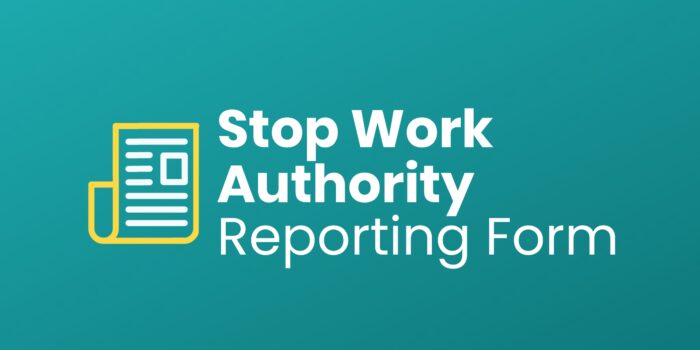24 Jul Risk Insights – Conducting Workplace Health and Safety Incident Investigations
When workplace health and safety incidents happen, it’s important to respond appropriately—that’s where incident investigations can help. Conducting an investigation allows employers to identify potential health and safety failings that led to the incident and make necessary workplace adjustments to help prevent future incidents. Review this guidance for more information on what workplace health and […]
16 Jun Stop Work Authority Reporting Form – Template
 In any organization, it’s everyone’s responsibility to help detect workplace hazards and prevent accidents. That’s why it’s crucial for your staff to be actively involved in workplace health and safety initiatives, such as a stop-work authority (SWA) program.
In any organization, it’s everyone’s responsibility to help detect workplace hazards and prevent accidents. That’s why it’s crucial for your staff to be actively involved in workplace health and safety initiatives, such as a stop-work authority (SWA) program.
Our two free downloadable samples:
- Stop Work Authority Program - outlines the rights and responsibilities of employees and contract workers in regards to stopping work when a perceived unsafe condition or behavior may result in an accident or other unwanted event.
-
Stop Work Authority Reporting Form - Employees and contract workers can use this form to report a perceived unsafe condition or behavior that may result in an accident or other unwanted event.
04 Jun Safety Matters: Trucking
 Driving a truck comes with a number of constant hazards that drivers need to be aware of in order to keep themselves and others on the road safe. Share the following Safety Matters with your drivers.
Driving a truck comes with a number of constant hazards that drivers need to be aware of in order to keep themselves and others on the road safe. Share the following Safety Matters with your drivers.
Avoiding Right Turn Squeeze Crashes
Large commercial vehicles can be challenging to maneuver, particularly on residential and city streets. Taking a turn too sharply or widely can lead to costly accidents and serious injuries. One common type of accident is the right turn squeeze crash, which occurs when a truck driver makes a wide right turn, leaving too much distance between the truck and the curb. When doing so, other drivers on the road may try to squeeze past the truck and could end up getting their vehicle caught underneath the truck’s trailer.20 May OSHA Updates Coronavirus Safety Enforcement Policies
On May 19, 2020, the Occupational Safety and Health Administration (OSHA) announced the following revised policies for enforcing OSHA’s requirements with respect to coronavirus: Updated Interim Enforcement Response Plan. OSHA will return to in-person inspections in many workplaces now that personal protective equipment potentially needed for inspections is more widely available. OSHA staff will continue […]
15 May Risk Insights: Stop-work Authority Explained
In any organization, it’s everyone’s responsibility to help detect workplace hazards and prevent accidents. That’s why it’s crucial for your staff to be actively involved in workplace health and safety initiatives, such as a stop work authority (SWA) program. These programs encourage employees to keep an eye out for potential workplace safety hazards, thus helping […]


 The U.S. Food and Drug Administration is drawing attention to two big national food recalls to prevent salmonella outbreaks. The advisories are focused on frozen shrimp and both bagged and bulk peaches.
The U.S. Food and Drug Administration is drawing attention to two big national food recalls to prevent salmonella outbreaks. The advisories are focused on frozen shrimp and both bagged and bulk peaches.